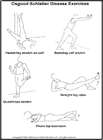
Osgood-Schlatter Disease Rehabilitation Exercises
You can start stretching the muscles in the back of your leg using the hamstring and calf stretches right away. When you have only a little discomfort in the upper part of your lower leg bone (tibia), you can do the rest of the exercises.
- Hamstring stretch on wall: Lie on your back with your buttocks close to a doorway, and extend your legs straight out in front of you along the floor. Raise the injured leg and rest it against the wall next to the door frame. Your other leg should extend through the doorway. You should feel a stretch in the back of your thigh. Hold this position for 15 to 30 seconds. Repeat 3 times.
- Standing calf stretch: Facing a wall, put your hands against the wall at about eye level. Keep the injured leg back, the uninjured leg forward, and the heel of your injured leg on the floor. Turn your injured foot slightly inward (as if you were pigeon-toed) as you slowly lean into the wall until you feel a stretch in the back of your calf. Hold for 15 to 30 seconds. Repeat 3 times. Do this exercise several times each day.
- Quadriceps stretch: Stand an arm's length away from the wall, facing straight ahead. Brace yourself by keeping the hand on the uninjured side against the wall. With your other hand, grasp the ankle of the injured leg and pull your heel toward your buttocks. Don't arch or twist your back and keep your knees together. Hold this stretch for 15 to 30 seconds. Repeat 3 times.
- Straight leg raise: Lie on your back with your legs straight out in front of you. Tighten up the top of your thigh muscle on the injured leg and lift that leg about 8 inches off the floor, keeping the thigh muscle tight throughout. Slowly lower your leg back down to the floor. Do 3 sets of 10.
- Prone hip extension: Lie on your stomach with your legs straight out behind you. Tighten up your buttocks muscles and lift one leg off the floor about 8 inches. Keep your knee straight. Hold for 5 seconds. Then lower your leg and relax. Do 3 sets of 10.
- Knee stabilization: Wrap a piece of elastic tubing
around the ankle of your uninjured leg. Tie the tubing
to a table or other fixed object.
- Stand on your injured leg facing the table and bend your knee slightly, keeping your thigh muscles tight. While maintaining this position, move your uninjured leg straight back behind you. Do 3 sets of 10.
- Turn 90° so your injured leg is closest to the table. Move your uninjured leg away from your body. Do 3 sets of 10.
- Turn 90° again so your back is to the table. Move your uninjured leg straight out in front of you. Do 3 sets of 10.
- Turn your body 90° again so your uninjured leg is closest to the table. Move your uninjured leg across your body. Do 3 sets of 10.
Hold onto a chair if you need help balancing. This exercise can be made even more challenging by standing on a pillow while you move your uninjured leg.
Written by Tammy White, M.S., P.T., for McKesson Health Solutions LLC.
Published by McKesson Health Solutions LLC.
This content is reviewed periodically and is subject to
change as new health information becomes available. The
information is intended to inform and educate and is not a
replacement for medical evaluation, advice, diagnosis or
treatment by a healthcare professional.
Copyright © 2003 McKesson Health Solutions LLC. All rights reserved.

